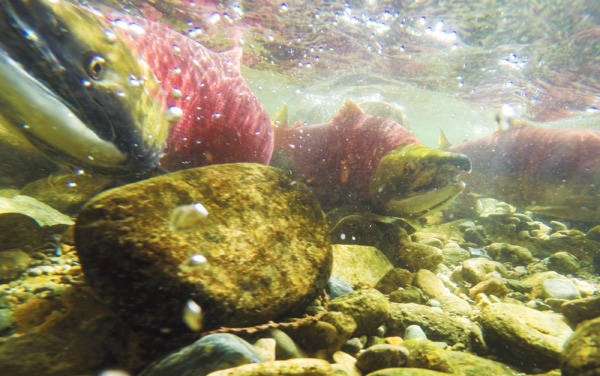I have been looking forward to this coming weekend for months.
While you are reading this column, I will be casting my double-handed, seven-weight switch rod to the steelhead swimming in the crystal clear waters of the Coquihalla River. I have only fished the Coquihalla a couples of times, but each time I have been rewarded with at least one steelhead.
All were released back into the fast-flowing waters of this magnificent stream.
When I am standing on the banks of the Coquihalla, looking up at the mountains that surround me, casting my line out to the far side of a turquoise-coloured holding pool, I cannot help but feel, well, a special connection to both the river and its history.
Standing there, making cast after cast, my mind sometimes drifts to those anglers that truly are a part of this province’s sport fishing history. Anglers who have recorded their thoughts and ideas for posterity. Anglers who are also authors.
Related: Column: Reading the water, taking in the sights
Roderick L. Haig-Brown has always been one of my favourite angling authors. He was a fly fisherman, a magistrate, radio broadcaster, university chancellor and conservationist who lived in Campbell River, B..C. He was also a prolific writer. The Seasons of a Fisherman is a marvelous collection of his four classic “seasons” books: Fisherman’s Spring (1951), Fisherman’s Winter (1954), Fisherman’s Summer (1959) and Fisherman’s Fall (1964), all compiled for the first time in one single volume.
This book is about far more than just fishing and the trappings and traditions that go along with the sport of fly fishing. I have read and reread all four of the season books many times. Each page draws me back to a simpler time – to an era when fishing was not so high tech and time spent casting a line was time spent communing with nature and breathing in the peace and tranquility that comes with standing on the banks of a river.
In my mind I have stood alongside Haig-Brown and watched as the early morning mist rose from the water. Together we have cast our lines and waited for a steelhead to explode on the other end of our lines. While I may not have ever met Haig-Brown, in a way I have come to consider him a sort of fishing partner – standing just upstream.
Related: COLUMN: Speaking loudly under one voice
Steelhead are looked upon with a certain reverence by many anglers. Perhaps that is why, over the years, I have been so often drawn to a series of fishing journals written by B.C. writer, angling historian and steelheader Art Lingren. The Dean River Steelhead Journal, Kispiox River Journal and Thompson River Journal all highlight the spectacular steelhead fishing to be found in our province. I have learned much about steelheading from his journals. One of my most prized possessions is a copy of his book, Fly Patterns of Roderick Haig-Brown which he gave me with each pattern that he had hand-tied.
What The River Knows by Wayne Fields is a book that winds its way through the northern wilderness, all the while exploring one man’s journey through middle age. In one way it is a celebration of nature in all its glory. It is also one man’s attempt to comprehend all the delights, triumphs and anguish that have marked his journey through life. The book tells of summer days spent fishing the runs and riffles of fast-flowing streams – including several streams known for their steelhead. I guess I can relate to much of what he writes.
Related: Column: Moving through the seasons
Steelhead are the anadromous form (fish which migrate from marine to freshwater environments to spawn) of rainbow trout. They are similar in appearance to rainbow trout, especially during their earlier life-cycle stages, but grow much larger in size. Mature steelhead vary in colour depending on the amount of time they have spent in fresh water as opposed to the ocean. The longer the time spent in fresh water, the more a steelhead looks like a rainbow trout – bright silver with orange and pink tints to its scales. However, with a shorter length of time spent in fresh water, they tend to appear more similar to a salmon, having dark blue backs with spots and silver sides.
All I know is that steelhead can be mighty hard to catch. Perhaps that is why they are so often referred to by anglers as the, “fish of a thousand casts.”
I also know that I am looking forward my time on the Coquihalla.
@SalmonArm
newsroom@saobserver.net
Like us on Facebook and follow us on Twitter
